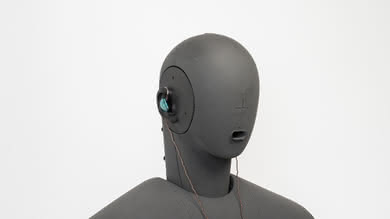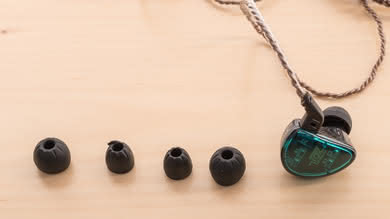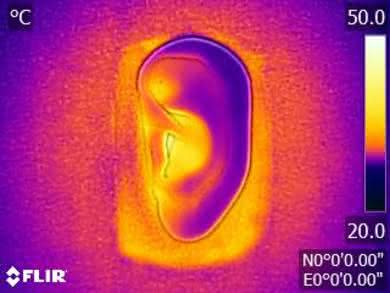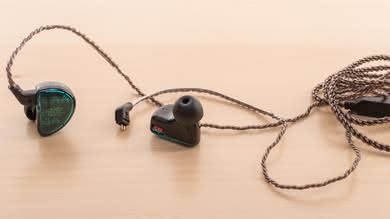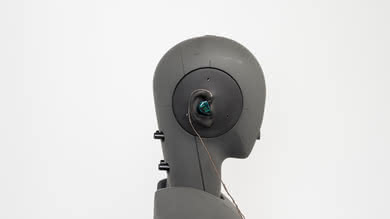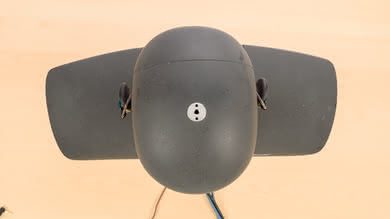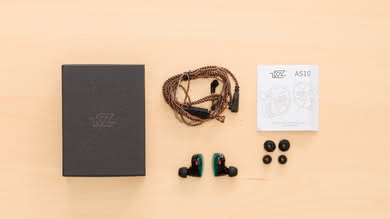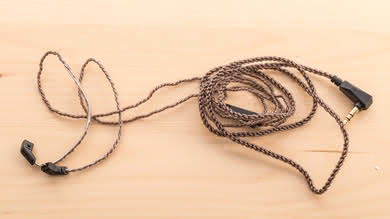The KZ AS10 are average mixed usage wired in-ears that look high-end and have a decent audio reproduction. They stand out with their transparent design and braided audio cable that's detachable and replaceable. The buds are angled for a better fit within the contour of your ears and provide great passive isolation. However, they are slightly bulky so listeners with smaller ears might not find them as comfortable and unfortunately, there’s no extra cable in the box. The ones we tested didn’t have in-line controls or a microphone, but KZ does offer a variant with both.
Our Verdict
Decent for neutral listening. They have a deep and punchy bass, an even and decently balanced mid-range and a good treble. However, they do sound a bit boomy due to the overemphasized bass while vocals and lead instruments sound like they are being pushed back in the mix. Like most in-ears, they have a poor soundstage which won't be ideal for more neutral listeners. Nevertheless, they are decent sounding in-ears for their price range and will sound good enough for most users.
-
Decent sound quality.
-
Good design.
-
Slightly bulky earbuds.
-
The no in-line remote variant is a bit limited.
Okay for commuting. They don’t let too much noise seep into your audio thanks to their great passive isolation, especially if you can find an air tight fit with the provided tip options. They also don’t leak much, so you can raise your volume to mask more ambient sound. Unfortunately, the variant we tested was not equipped with an in-line remote. On the upside, they are very portable and should fit in most pockets.
-
Decent sound quality.
-
Good design.
-
Slightly bulky earbuds.
-
The no in-line remote variant is a bit limited.
Decent for sports. The flexible ear-hook design will keep the earbuds stable enough during exercise. Being in-ears, they are lightweight and portable enough to keep on you at all times. On the downside, the variant we tested didn’t have in-line controls. However, the variant with the in-line remote doesn’t offer volume controls which isn’t ideal for working out.
-
Decent sound quality.
-
Good design.
-
Slightly bulky earbuds.
-
The no in-line remote variant is a bit limited.
Average for office use. If you can get a good air-tight seal, they can block passively a great amount of ambient noise. Their leakage performance is excellent, so you can mask more noise by raising your volume without bothering colleagues. Unfortunately, the variant we tested did not have a microphone for making calls. Even if these are decently comfortable, in-ears probably aren’t a great choice for an 8-hour shift.
-
Decent sound quality.
-
Good design.
-
Slightly bulky earbuds.
-
The no in-line remote variant is a bit limited.
Passable for gaming. They are a decent sounding pair of headphones, their design is decently comfortable and they have a basically latency-free wired connection. Unfortunately, the model we tested does not have an in-line microphone so only audio will be provided when connected to your gaming system. They are also not customizable like typical gaming headphones. The short cable isn't as ideal as some wireless headsets we've tested. On the upside, the version that comes with an in-line microphone should be compatible with your console controller or PC.
-
Decent sound quality.
-
Good design.
-
Slightly bulky earbuds.
-
The no in-line remote variant is a bit limited.
- 6.6 Neutral Sound
- 6.0 Commute/Travel
- 6.5 Sports/Fitness
- 5.8 Office
- 4.1 Wireless Gaming
- 6.1 Wired Gaming
- 2.5 Phone Calls
- Updated Aug 29, 2023: Added a comparison to the Razer Moray in the Comfortbox.
- Updated Nov 19, 2021: Converted to Test Bench 1.5.
- Updated Mar 02, 2020: Converted to Test Bench 1.4.
- Updated Nov 21, 2019: Converted to Test Bench 1.3.1.
- Updated Nov 21, 2019: Converted to Test Bench 1.3.
- Updated Oct 19, 2018: Review published.
- Updated Oct 17, 2018: Our testers have started testing this product.
- Updated Oct 17, 2018: Early access published.
- Updated Oct 16, 2018: We've purchased the product and are waiting for it to arrive in our lab.
- Updated Oct 15, 2018: The product has arrived in our lab, and our testers will start evaluating it soon.
Compared To Other Headphones
Overall, the KZ AS10 are decent wired in-ear headphones that are very similar to the KZ ZS-10. They look great due to their transparent design, and they're more comfortable than typical in-ears thanks to their angled earbuds. They also come with a braided, detachable, and replaceable cable that makes them more durable, but no extra cable comes in the box. The AS10 have decent audio reproduction that's very similar to the ZS10. Their passive noise isolation is great, and their leakage performance is excellent, making them quite versatile for different types of usage. The model variant we reviewed did not have an in-line remote and mic, but another variant does. They look more high-end than their actual price range.
See our recommendations for the best noise cancelling earbuds, the best wired headphones, and the best cheap earbuds.
The KZ AS-10 and the KZ ZS-10 are very similar headphones. The ZS-10's sound is more accurate, while the AS-10 has more bass and a bit more punch to it. Design-wise, they are nearly identical. Both have bulky angled earbuds; the only difference being the AS-10 are a bit thinner, maybe making them a bit more suitable for everyone and more comfortable for smaller ears. The AS-10 also have better passive noise isolation.
The KZ AS10 are better-sounding headphones than the Shure SE215. They also look better and have a better build quality, thanks to the braided and replaceable cable. You can also find a variant of the KZ in an in-line remote and mic, which the Shure lacks. However, the Shure are more comfortable and offer slightly better noise isolation. The better sound quality and cheaper price make the KZ a better choice over the Shure.
The KZ AS10 will be a better option than the KZ ZST. Their overall build feels slightly better made than the ZST and their sound is more accurate for critical listening. Also, their fit is better at isolating noise, so they’ll also be more versatile if you want to use them for commuting. On the other hand, the KZ ZST are noticeably more affordable and offer great value.
The KZ AS10 are slightly better headphones than the similar KZ ZSN. Their sound profile is more accurate, especially in the treble range. The AS10 have a different fit that isolate more ambient noise and will be a better option for commuting. Their fit also creates a more air-tight seal, which means they’ll leak less and will be better suited to listen to music at the office without disturbing colleagues. On the other hand, the ZSN have a more high-end look thanks to the metal-finish backplate on the earbuds, but that’s about it.
The 1More Triple Driver headphones are slightly better than the KZ AS10. The 1More have more accurate audio reproduction and also have an in-line remote with volume control. The mic version of the KZ doesn’t even have this feature. On the other hand, the KZ look better and have more durable build quality, especially with the braided and replaceable cable. The KZ look and feel more premium than the 1More.
The KZ AS10 are more versatile in-ear monitors than the Razer Moray. They have very good noise isolation performance, making them better-suited for commuting since they can block out more of the low rumble from bus engines. Their sound profiles are similar, but the KZ has more bass to complement thumpier music genres and action and RPG games. However, the Razer are more comfortable and come with a much larger selection of ear tips, allowing you to find the best fit for long gaming sessions.
The KZ AS-10 are better multi balanced armature headphones than the Westone W40. Their sound quality surpasses significantly the W40. The Westone, on the other hand, have an in-line mic and remote with volume control, that the mic variant of the AS-10 doesn’t have. The W40 also have a better design, thanks to more comfortable earbuds, and are more portable thanks to their solid case. On the other hand, the KZ AS-10 have better sound performance and are cheaper, making them an obvious better choice over the W40.
Video
Test Results
The KZ AS10 have a stylish look that would make you think their price range is higher than it actually is. The earbuds have transparent casings that lets you see the electronic parts of the headphones. The braided cable is also a nice addition to their premium feeling. They are slightly bulky, but the earbuds are angled to give you a more stable fit than most in-ears. If you're not a big fan of the transparent backplate, take a look at the KZ ZSN, which have a metal-finish plate and looks a bit more high-end.
The KZ AS10 are decently comfortable in-ear headphones. The earbuds are angled to suit the contour of your ear for a better fit. They are quite bulky, which may not fit every listener, especially people with smaller ears, but they are thinner than the similar KZ ZS-10. On the upside, they also come with different tip options to help you find a better, more comfortable fit and air-tight seal. If you're looking for lighter earbuds with more included ear tips, check out the Razer Moray. They're less bulky than the KZ and come with three sets of silicone ear tips and three sets of foam ear tips, which some users find creates a more comfortable seal.
The KZ AS10 we tested do not have an in-line remote with a control scheme, but there is a version with one multi-function button and no volume controls.
Like most in-ears, the KZ AS10 are very breathable, and you shouldn’t sweat more than usual while wearing them. They are a little larger than the usual in-ear designs, so they will trap a bit more heat, but this shouldn't be very noticeable. They are breathable enough for multiple different casual usages and for working out.
The KZ AS10 have a good build quality and come with a braided and detachable cable, but unfortunately, they don't come with an extra one in the box. The braided cable seems durable enough for most usages and looks great, but it is not very thick. On the upside, you can replace it if it gets damaged which makes the AS10 more durable than most typical in-ears. The earbuds are dense with see-through casings that should handle a few drops without breaking. For similarly designed headphones, take a look at the Tin Audio T3 or the BGVP DM6.
The KZ AS10 are stable headphones due to their ear-hook-like design. It’s not a real rubber or plastic hook, but the flexible cable is designed to go behind your ear and it is covered by a slight coating for comfort. They aren’t stiff hooks but are stable enough for most sports and we don’t expect the headphones to fall out of your ears, unless the cable gets pulled or stuck on something.
The frequency response consistency of the KZ AS-10 is excellent. If the user is able to achieve a proper fit and an air-tight seal using the assortment of tips that come with the headphones, then they should be able to get consistent bass and treble delivery every time they use the headphones. Compared to the ZS-10, the AS-10 have slightly thinner and smaller buds, so they may be able to provide a better and more consistent fit for those with smaller ears.
The bass of the KZ AS10 is great. LFE (low-frequency extension) is at 10Hz, which is excellent. Low-bass is within 1dB of our neutral target, meaning these headphones produce just the right amount of thump and rumble, which is common to bass-heavy music and sound effects. Mid-bass, responsible for the body of bass guitars and the punch of kick drums is flat but overemphasized by about 2dB. High-bass, responsible for warmth is overemphasized by more than 4dB, making the bass of these headphones a bit boomy and muddy.
The mid-range is very good. The overall response is quite even and decently balanced. However, the broad 4dB recess centered around 700Hz pushes vocals and lead instruments towards the back of the mix by giving more emphasis to the bass and treble frequencies.
The treble performance of the KZ AS-10 is good. Low-treble is over our neutral target by about 2dB, bringing a bit of excess intensity and brightness to the vocals and lead instruments. Mid-treble is rather uneven, which makes the reproduction of sibilances (S and T sounds) a bit inconsistent, by overemphasizing some and underemphasizing others.
The imaging of the KZ AS10 is great. Their weighted group delay is at 0.19, which is among the lowest we have measured. The group delay graph also shows that the entire response is well below our audibility threshold. This ensures a tight bass and a transparent treble reproduction. Also, the L/R drivers of our test unit were very well-matched in frequency, amplitude, and phase response. This is important for accurate placement and localization of objects, such as footsteps and instruments, in the stereo field.
The soundstage is poor. This is because creating an out-of-head and speaker-like soundstage is largely dependent on activating the resonances of the pinna (outer ear). The design of in-ears and earbuds is in such a way that fully bypasses the pinna and doesn't interact with it. Also, because these headphones have a closed-back enclosure, their soundstage won't be perceived to be as open as that of open-back earbuds like the Apple AirPods (1st generation) Truly Wireless, or the Bose SoundSport Free.
The isolation performance of the KZ AS10 is great. They surprisingly performed much better than the similar ZS10, and we suspect this is due to the slightly smaller and thinner design of the AS10 which allows for a closer and tighter fit in the ear. In the bass range, where the rumble of airplane and bus engines sits, they achieved about 14dB of isolation which is above-average. In the mid-range, important for blocking out speech, they reduce outside noise by more than 24dB, which is very good. In the treble range, occupied by sharp S and T sounds and air conditioning systems, they isolate by more than 47dB, which is outstanding.
The leakage performance is excellent. These in-ears basically do not leak so there's no need to worry about disturbing the people around you unless you are blasting your music in a very quiet place. With the music at 100dB SPL, the leakage at 1 foot away averages at 27dB SPL and peaks at 39dB SPL, which is way below the noise floor of an average office.
The AS10 do not have a microphone and therefore, the recording quality has not been tested.
The AS10 do not have a microphone and therefore, the noise handling has not been tested.
The AS10 are passive headphones without active components or a battery.
They do not have a compatible app or software support for added customization options.
These headphones are wired and don't have a Bluetooth connection.
The KZ AS10 headphones have practically no latency due to their wired connection. This also means that their range is limited by the used cable's length.
The KZ AS10 headphones come with a replaceable 1/8" TRS audio cable without an in-line mic or remote that will only provide audio when connected to your phone, PC or console controllers. There is a model variance that comes with an in-line remote and mic.


